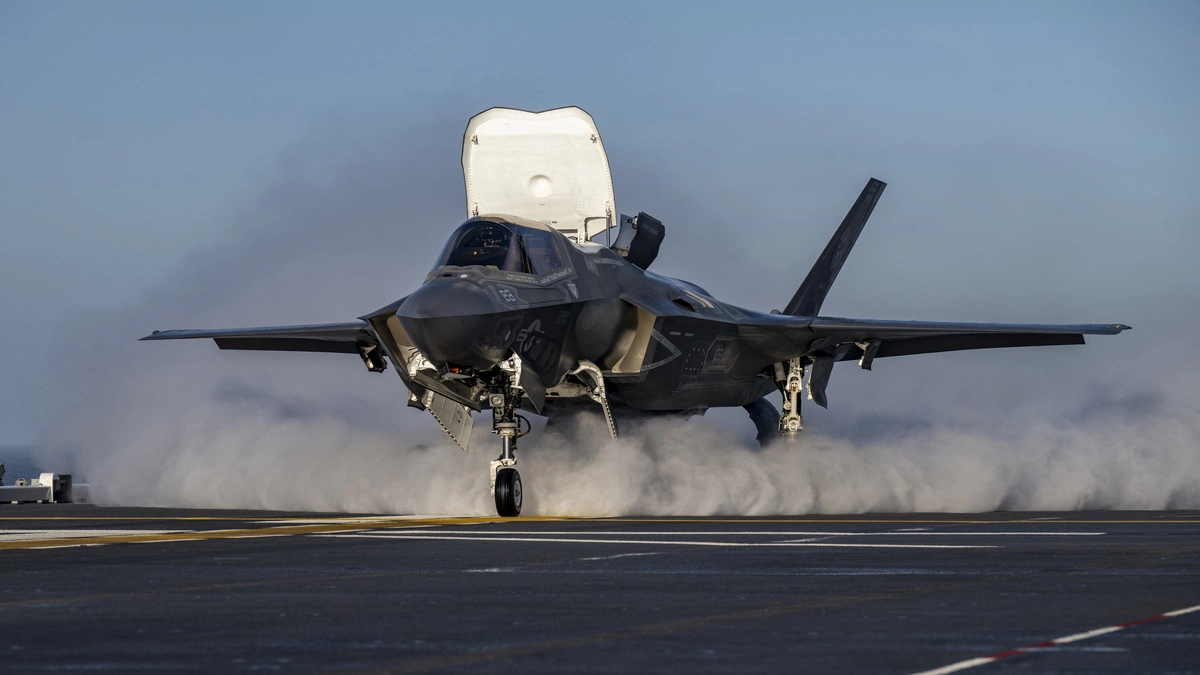Japan is preparing to induct its first operational F-35B short takeoff and vertical landing (STOVL) stealth fighters, with the arrival of four aircraft at Nyutabaru Air Base in Kyushu on August 7, 2025. The deployment marks the beginning of Japan’s first carrier-capable fighter force in modern times and is in line with the country’s strategic posture near the disputed East China Sea and Taiwan Strait.
Naval Aviation Revival: From Destroyers to Carriers
F-35Bs are set to be operated from Japan’s Izumo-class helicopter destroyers, which are being converted to support fixed-wing aircraft. U.S. Marine Corps F-35Bs successfully landed on the JS Kaga in tests conducted in 2024, validating Japan’s ability to host carrier-based operations. The full conversion of both JS Izumo and JS Kaga is expected to be completed by 2027.
The conversion marks Japan’s first return to carrier aviation since World War II, increasing its ability to project air power into the Pacific Ocean.
- A U.S. Marine Corps F-35B from VMFA-242 made a vertical landing on the Japanese ship Izumo off the coast of Japan on October 3, 2021. This marks the first F-35B operation on a Japanese ship, enhancing U.S.-Japan interoperability and regional security. (Lance Corp. Tyler Harmon/USMC)
Strategic Posture Amid Regional Tensions
Japan’s rapid deployment is a direct response to the growing Chinese military presence in the East and South China Seas. By deploying F-35Bs to the Nansei Islands and eventually aboard Izumo-class ships, Tokyo aims to strengthen its defensive reach on key sea approaches and strengthen its alliance with the United States.
The location of Nyutabaru Air Base on Kyushu allows for rapid forward deployment to the Senkaku Islands region and other hotspots.
Stealth and flexibility in a compact package
The F-35B variant gives Japan the ability to launch fifth-generation aircraft from short or damaged runways, or from amphibious ships and aircraft carriers. Capable of vertical landing and short takeoff, the aircraft is equipped with stealth features, advanced sensors and the ability to share real-time targeting data.
Japan plans to acquire 42 F-35Bs in addition to 100 F-35As, one of the largest F-35 fleets in the Indo-Pacific.

- JS Izumo (DDH-183) is the lead ship of the Izumo-class in the Japan Maritime Self-Defense Force (JMSDF). Officially designated as a multi-purpose operational destroyer, she began conversion to a light aircraft carrier in 2022. (Japanese MoD)
Infrastructure and integration challenges
While this deployment represents a major leap in Japan’s air power, it also presents logistical obstacles. Nyutabaru Air Base is still undergoing upgrades to support STOVL operations, and vertical landing tests are being evaluated to reduce noise and safety concerns.
Carrier operations will require specialized training, maintenance facilities, and coordination with U.S. forces to ensure interoperability in the event of a regional crisis.
Regional Shift in Deterrence
Beijing has expressed concern over Tokyo’s growing military capabilities, warning that Japan’s move toward carrier aviation could provoke instability in East Asia. However, Japanese officials claim the measures are strictly defensive and necessary to maintain freedom of navigation and regional stability.
Analysts say the introduction of the F-35B significantly enhances Japan’s deterrence posture, making it harder for adversaries to use gray-zone tactics or maritime coercion.

- An F-35B Lightning II makes a vertical landing on the Japan Maritime Self-Defense Force’s Izumo-class multi-functional destroyer JS Kaga (DDH-184) during a developmental test in the eastern Pacific Ocean on November 2, 2024. (Dan Wiedmann/Wikimedia)
Conclusion
With the arrival of the F-35Bs this August and full naval integration by 2027, Japan is reestablishing itself as a formidable maritime air power. This change not only marks a doctrinal evolution for the Japan Self-Defense Forces but also signals a deepening of its strategic alliance with the United States in the rapidly changing Indo-Pacific security environment.
FAQS
Amid rising regional tensions, particularly due to China’s aggressive actions in the East and South China Seas, Japan deployed its first three F-35B Lightning II jets to Nyutabaru Air Base in southern Kyushu to bolster its defense capabilities. These advanced aircraft, capable of short takeoff and vertical landing (STOVL), will operate from converted Izumo-class helicopter carriers, marking Japan’s return to carrier-based aviation after World War II.
The F-35B jets provide Japan with versatile, stealthy, and responsive air power. Their STOVL capability allows them to operate from short or damaged runways and amphibious ships, extending Japan’s defensive reach. Equipped with advanced sensors and real-time data-sharing capabilities, the jets strengthen Japan’s deterrent posture against potential adversaries
Japan’s deployment of the F-35B jets coincides with joint military exercises involving the US and allies, such as the recent Resolute Dragon exercises. The exercises, which involve more than 19,000 troops, underscore Japan’s commitment to regional security and its strategic partnership. The integration of advanced missile systems, such as the US Typhoon, capable of launching Tomahawk and SM-6 missiles, further enhances deterrent capabilities in the region
While the F-35B jet enhances Japan’s military capabilities, there are also logistical challenges. Construction of the planned F-35B training facility on the island of Megeshima has been delayed, forcing operations to continue from Niutabaru Air Base. In addition, vertical landing tests are being conducted to address noise and safety concerns, ensuring readiness for full-scale operations of these advanced aircraft.








Leave a Reply